“Something is there”: Filmmaking in Multiple Realities
Lonnie van Brummelen & Siebren de Haan
“Man himself is just one fact among others, to whom no pride of place should be given a priori.”{1}
— André Bazin
In 2008, Ecuador was the first nation to adopt a new political constitution, which acknowledges the juridical personality of non-human entities. Trees, stones and rivers were granted rights of their own, similar to people. The new law was based on the worldview of Ecuador’s indigenous population for whom a “community” necessarily includes both human and non-human constituents. The Law of the Rights of Mother Earth was passed in Bolivia two years later, which places the earth deity Pacha Mama at the center of all life.
Then this year, the New Zealand Parliament passed a bill, which declared the Whanganui river a “living entity” with inherent rights. The bill was the outcome of a long battle by members of a Māori tribe who perceive the river as their ancestor.{2} A few days later, the ruling of a high court in India established two more rivers, the Ganga and Yamuna, as “living entities.”
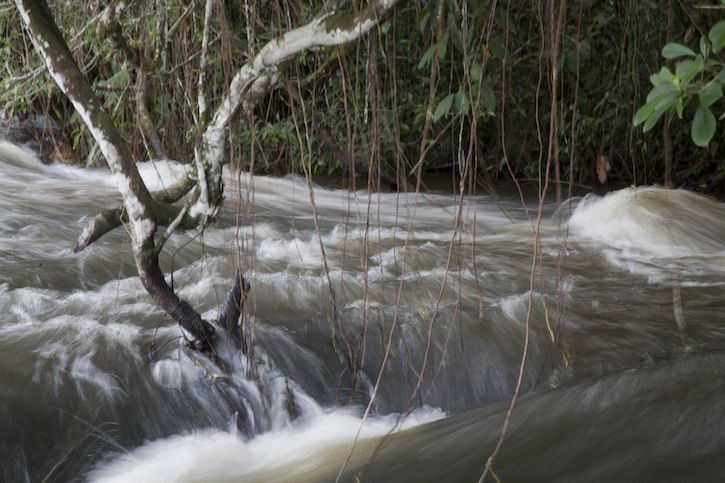
These new laws hint at the possibility of an extended democracy in which non-human entities can participate. However, while aiming to protect the ecologies of the earth against the damages caused by ongoing resource extraction, the laws have not been able to halt the industries in their tracks. The rights of nature prove to be difficult to implement in a globalized world order, where “business as usual” prevails. This reminds us that change is not brought by courts alone. It requires substantial public pressure.
Nowadays, it seems easier to picture the end of the world than to imagine the end of capitalism. Thinking about change therefore starts with the imagination. What could a world look like that lies beyond the grid imposed onto reality by the dominant systems of power? This is what artists, filmmakers, academics and other cultural producers can help to envision.
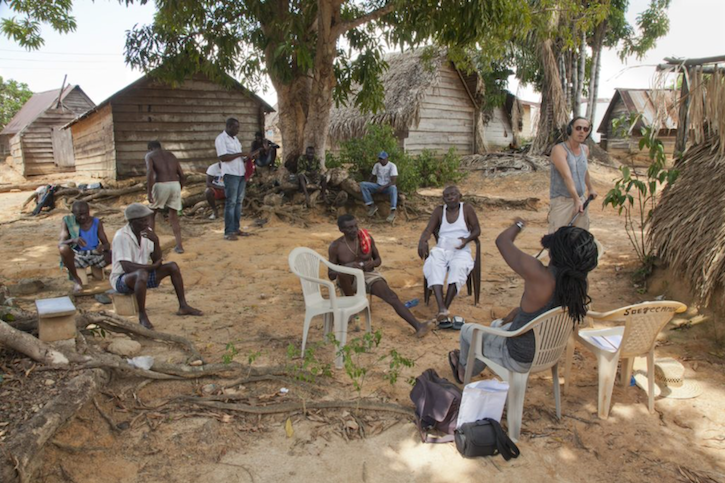 Conversation with village elders, Lebidoti, Suriname, 2015.
Conversation with village elders, Lebidoti, Suriname, 2015.
The film, Citizens of Nature, which we have been working on for nearly three years, seeks to reproduce how Surinamese communities that live in the Guiana Shield rainforest organize the participation of other-than- human entities in their daily processes of decision making.{3} As Dutch nationals we are historically linked to these communities. The land that is now Suriname was explored and conquered by different European powers before coming under Dutch rule in the 17th century. Suriname gained independence in 1975, but maintained strong ties with its former colonizer. Dutch is still the official language, and almost half of the country’s population lives in the Netherlands.
In the Dutch classrooms where we received our education, Suriname was mainly discussed as a colony that had not been very profitable. The wealth of Amsterdam’s canal houses, however, seems indicative that this narrative is incomplete. What was also left out of the story, was the misery that our forefathers caused to the hundreds of thousands of West-Africans whom they shipped across the Atlantic to work on Suriname’s plantations as slaves.{4} Some of these deported were able to free themselves. Building on their African knowledge, they founded new communities deep in the rainforest.{5}
To get a glimpse of the cosmology of these Guiana maroons, we spent eight months in situ. Village elders, but also younger men and women explained to us in detail how they lived with the forest. They patiently demonstrated the procedures to consult ancestors, gods and forest spirits. Meanwhile we learned simple wisdoms, such as that there are no useless plants, only uninformed people.{6}
Every now and then one of our maroon collaborators would say: “Something is there,” referring to the presence of an unknown entity. Whether it was a deity, an animal, or something else would remain unclear. These presences were undetectable for us so-called moderns. We came to understand this as the expression of a worldview in which humans share the world with other subjectivities, and not-knowing is a way of acknowledging that condition.
But during these conversations we also heard another tale, one of ongoing exploitation and struggle. In the times of slavery, the maroons battled fiercely against the Dutch colonial oppressors. In current days, they are confronted with multinational firms who capitalize on the natural resources on their ancestral grounds. To our surprise, we discovered that we too were agents of the trickery system of accumulation by dispossession, and not by the deeds of our forefathers, but by the very act of making this film.
As artists, we have not been disciplined by the division of labor of the film industry. We have had the privilege to work with no boss to obey. But realizing a film in the rainforest does require a budget. We therefore applied for a special grant that aims to stimulate artists to produce a feature film.{7} The funders of the grant required that we would adopt the protocols of feature film production. A film producer had to be in charge both financially, creatively and legally. As artists we were required to sign over our rights.
A business model aimed at generating profit was now imposed onto the film project. The producer created an inflated budget with a complex recoupment scheme. Substantial parts of our labor were listed as “deferment.” It meant that the work would be paid once the box-office money came through. The chance of us actually receiving this postponed fee was nihil. After all, artistic documentary experiments are usually no blockbusters. Nonetheless, the producer charged a full commission over the value of our unwaged labor.{8}
Reproducing the radical democracy of the forest communities from within the confines of this top-down model proved to be a challenge. The producer sent us into the forest with a stack of releases to be signed by all those participating in the film. By signing the contract, our collaborators would transfer all their rights regarding their appearance and contribution “completely and irreversibly” to the production company so that the producer can “exploit the film.”{9} There were no contracts for rocks, ancestors, or forest spirits. That other-than-human entities might have rights too had apparently not yet been internalized by the film industry.
The first captain to read the release was so angry about its content that he threatened to advise all his clan members not to participate in the film. Only after extensive negotiations with all parties involved we were able to find an ambiguous middle ground.{10}
Based on the discussions and the stories that our collaborators had been willing to share, we composed a script. In the film, members from different villages present the scenes before the camera, while vegetation, clouds, streaming waters, and rock formations perform as fellow actors.{11}
“If nature put it there, art has no business removing it.” This is what Roberto Rossellini replied, when a cameraman proposed to move a boulder that was disturbing the composition.{12} Critical circumstances, however, sometimes require that one takes the boulder from its place and carries it up the mountain, hurling it down at the right moment to smash an opponent. This particular insurgent action was put into execution by maroon ancestors when one of their villages was attacked by colonial troops.
To express such different modes of involvement, the film alternates between two visual regimes: receptive observation and manipulative intervention. For the most part, the camera will stand on its own legs, calmly observing the scenery with deep focus, wide framing, slow panning. Such camera work, we feel, allows the parliament of things to present itself.{13}
But the film also stages the perspectives of possible subjectivities by reappropriating dynamic camera techniques from narrative cinema.
Occasionally, the camera-eye may seem possessed by a Maroon ancestor who is preparing a battle action. The next moment it can incarnate as an undefined outsider, prowling around with dodgy intentions: perhaps a colonial forefather, or a concessionaire looking for profit, or us bakra’s (westerners) capturing images in the rainforest.{14} It might also change into a jumping forest spirit or a bellbird and fly away.
“Two Songs from Saamaka,” from CITIZENS OF NATURE (Work in Progress).
Written in between two shooting periods
Lonnie van Brummelen and Siebren de Haan
Amsterdam, June 23, 2017
****
CITIZENS OF NATURE
(working title)
Excerpt from script with camera notes.
1. NONGO
The image is almost abstract. No vegetation. No details. White shards of fog float in opposite directions. Rock formations vanish and emerge. They seem black, a rusty brown color, or reddish. Geological strata can be read from their surface. We appear to look into an abyss of time and fail to grasp the scale of things.
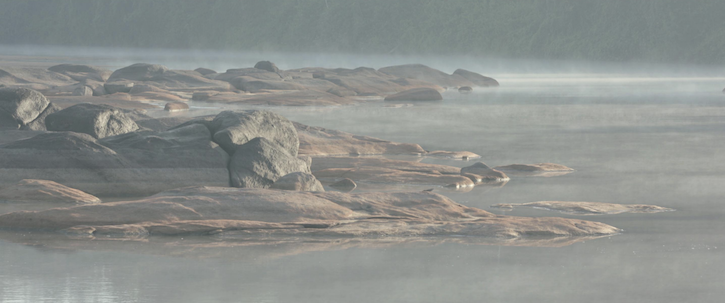
VOICE-OVER
It happened in the year when Agbago was installed as gaama, that someone delivered a message to us in nongo (the language of metaphor) that we did not understand. He said that the message had come to him in a dream and was intended for all descendants. They, and with that he meant the spirit world, had told him that they had seen a great sea, whose water was rising higher each passing day. The creeks were full, but it did not rain. The water in the rivers had risen so much that not even the birds had a place to live anymore, because all the treetops were submerged. The fish died and a famine broke out, because the sea had swallowed all the arable land. A great number of people were surprised by the water during sleep. We had to hurry to leave. Where we should go we did not know, because the water had us surrounded. Each chose their own way. Families were divided. And so it remained. The sea remained.
{15}
The sun tries to burn a hole into the dense layer of fog. A silhouette
appears. It is a boy, inspecting his nets. The sun breaks through.
2. THE LIMITS OF WHAT CAN BE TOLD
The camera slowly pans through an idyllic landscape. In the distance we hear a discussion. It appears not intended to be overheard by outsiders. The pan ends up with a group of people in the shadow of a tree. We see them from afar.
OLD MAN 1
The part that I know, is there. Yet I do not want to tell it.
OLD MAN 2
Well, not everything can be said. An oath has been made that certain things should remain secret.
YOUNG MAN
They won’t force you to. Certain things we won’t tell them.
OLD MAN
We’re not allowed to tell things that we don’t know well.
YOUNG WOMAN
That’s true. I don’t like: “That’s what I’ve heard.” I do like: “This is what I myself have seen.”
OLD MAN
Yes, but the story that they call “history”, the things of the past, that is mostly a matter of: “I have heard…”
OLD MAN 3
We have already poured out libations, because only the gods know better. These people may have come with bad intentions. They may be fooling us. But you and I have no way of knowing.
OLD MAN 1
Never tell more than half of what you know. Especially not about our sacred things.
OLD MAN 2
Of course there are people who will tell everything, but the tradition is that we are tight-lipped.
OLD MAN 3
The Awonenge, the old people who have heard the guns of war, when you are in real trouble, you call out their name.
OLD WOMAN
That’s right. The Awonenge give you strength.
OLD MAN 3
If you reveal their secret, you will break the bond with these spirit elders. So we cannot do that.
YOUNG MAN
One cannot tell everything to an outsider, but what we will tell, may help us and may help the forest.
Medium-wide shot, long lense, from a distance. The persons who participate in the conversation can be seen and heard more clearly.
OLD MAN 2
We know what we should tell, what we are allowed to tell, and how far we can go.
OLDER WOMAN
Don’t make waves like a motorboat.
OLD MAN 3
Never send the boat directly downstream.
OLD MAN 1
Do not blow the horn.
Close-up of old man, long lens, lengthy silent shot.
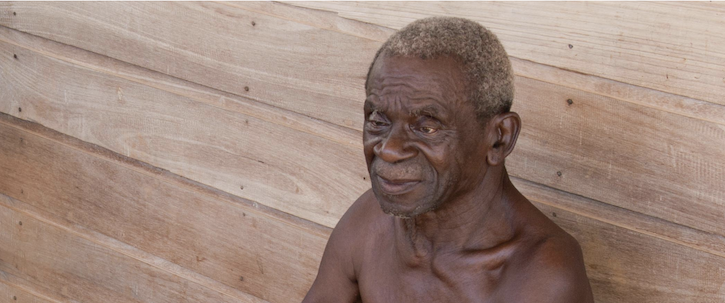
Wide shot, the conversation continues.
YOUNG MAN
In any case, I have cleaned out my ears to hear clearly what will be told.
5. ENCOUNTERING WAMBA
Tilt down from the sky to the branches of a tree. A second smaller tree sprouts forth from the the trees crown as if another entity has settled in. The tree is located at the banks of the river. A man is standing in its shadow. At first we see him in a wide shot, then in medium-close. He narrates.
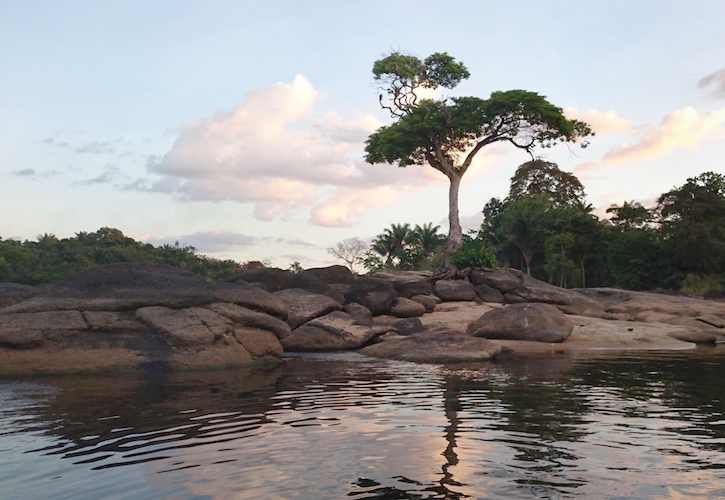
NARRATOR
The atmosphere on the plantations was agitated. There were insurrections going on. The slave masters had brought warriors from Africa who were meant to control the slaves. Our ancestor was one of them. He also was a slave, but he had the job to liaise with other plantations. Which is why he rode a horse.
On one of the plantations that he used to visit, he had a lover. She was from the African Kingdom called Dahomey. This woman worked in the house of the slave master. Most slaves worked on the plantation, but the young, pretty women would work for the plantation master as his mistresses. It was impossible for a slave to have a woman who worked at the house of the white master as his lover. This is what angered our ancestor.
On the plantation where she worked, it was the black men and women who planted the sugar cane, it was them who ground the sugar cane, but the whites were the owners of the sugar cane juice. Black people weren’t allowed to drink that juice.
One day our ancestor arrived there on horseback. The woman took the white man’s glass, poured it full of sugar cane juice, and gave it to the black man. Our ancestor drank the juice from the glass of the white man. Mind you, not a drop of the sugar cane juice is allowed to touch the lips of a slave. But here he was, drinking a whole glass until it was empty.
Someone saw it, and told the slave master. That white man desired the black woman, but he did not see her as a woman he loved. That she gave cane sugar juice to our ancestor frustrated him more than the love he felt for her. He whipped that woman until she died. Then they brought her dead body to our ancestor. “Here is your lover,” they said. Following this, they beat him, too, until he passed out. They left him to die.
After a while our ancestor became possessed by the spirit of the deceased woman. He cried “Meuhmmm!” and ran off into the forest, crying out her great name.
The forest god that is called Wamba responded to his calls. The god guided him to a group of Indians.{16} They welcomed him, bathed him, gave him food. They cared for him until he was cured. Then he travelled further upstream. It was Wamba who led him here. Wamba was the first god by whom our ancestor became possessed. Wamba.
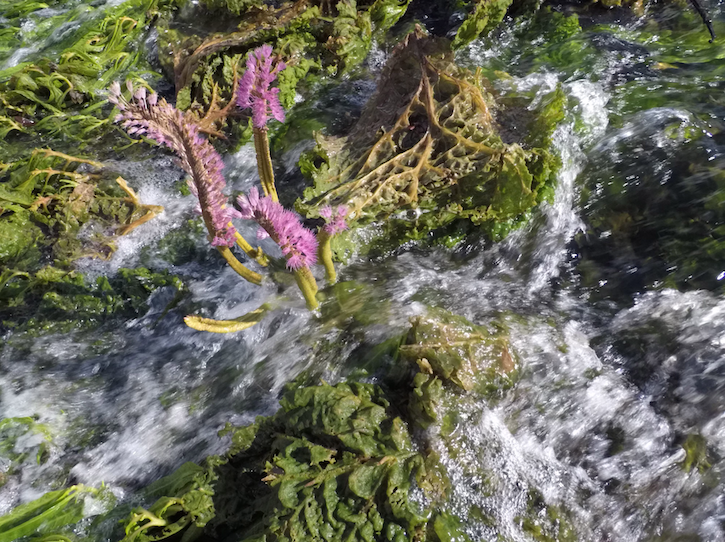
The narration is interspersed with images of the overgrown waterfall Tapawatra. Water flows through the dense mass of entangled plants. At the end of the tale the camera slowly descends from the tree. It wanders along the waterside and retreats into the dark forest.
12. GOD OF THE PLACE
In an open spot in the forest, a young man is setting up a gateway. He cuts branches from a maripa palm and uses them to make the span. The camera observes the construction work in wide overviews and in medium-close framing.
VOICE-OVER
We and the forest live together in a certain way. One of the rules is that if you go into the forest with the intention to live there, you raise the azan: you put the young, yellow leaves of a particular kind of palm tree upright and place a lump of chalky earth underneath it. This is a way of contacting a local deity. After that you say a prayer and then you leave.
When you return, you will learn if the forest agrees with you or not. Sometimes the forest is negative, and the place rejects you. When that is the case, the spirit throws the chalk to the ground. Our kin group had to ask four times in this manner if we could settle in the place where our village is now located, before the forest finally allowed us to stay. And that same god that rejected our village three times, it took possession of my grandmother. Its spirit prepared the way for others, to also enter her. Eventually that woman was possessed by no less than seven gods.
The young man building the azan arch looks up and enters into dialogue with the voice-over.
YOUNG MAN
People from the land of whites will never understand this. Are we not going to talk about the teachings of the apunku (forest spirits)?
VOICE-OVER
Okay. If you fell a tree in which an apunku houses, or if you kill an animal inhabited by an apunku, you disrupt that spirit in the place where he resides. The spirit will then go looking for a new home. It will not move into a tree or an animal anymore. It will move into someone in your environs: your cousin, your son, your grandmother.
When you receive a spirit, your life pattern changes, because a spirit now joins your own spirit. You share your body with that spirit. You will go on together.
Perhaps you received the spirit of an aira (a rodent). The aira likes sugar cane, so you will eat this often. If you received the spirit of a cayman, you will be able to dive for catfish lying under the rocks, because the cayman knows that method.
By using herbs, we are able to speak with your spirit. It then tells us its rules. This way we also find out if your spirit is male or female. And we gain access to its wisdom. Because an apunku knows much of the forest. The young man departs. The azan stays in the forest. An unknown entity roams about. Water drops arise spontaneously on the leaves of a plant. A deer stands stock-still and watches the scene.
25. CONCESSIONS
An abundant vegetable garden in the forest. Banana trees, cassava plants, bitter melon. While female voices testify, the images reveal that not human experience but plant life is the subject of the scene. Wide overviews and close-ups of foliage and fruits. Women are cutting, picking and sooting, obscured by the plants and trees. Quietly, we hear the sounds of their manual labor.
FEMALE VOICE 1 (off screen)
The children came to tell us that there were Chinese people in the forest. They had placed heavy machinery and containers in my vegetable garden. I told them: “I am working here.” But they replied: “We have the proper documents.”
My peanut plants had all been destroyed. There were fallen banana trees everywhere. I do not know how much was lost, because as forest persons we do not have the habit of counting the crops in the field.
FEMALE VOICE 2 (off screen)
The Chinese practice clearcut logging. They cut down every tree. From kankantrie to kwatakama, they fell them all. They even remove the smallest twigs. Often one cannot tell where trees have been felled. The trunks are pulled from the ground, with roots and all.
FEMALE VOICE 3 (off screen)
They block the creeks, so that their bulldozers can pass. We drink water from those creeks, so this leaves us without drinking water. The forest turns into a swamp.
FEMALE VOICE 4 (off screen)
The animals take off, because if you get rid of all trees, there are no more fruits for them to eat.
Slow fade out of image. Slow fade out of forest sounds.
FEMALE VOICE 3 (off screen)
The trees that they don’t need, they leave in the forest to rot away. They tear them down, but don’t use them. That is destruction.
In black, in silence.
FEMALE VOICE 1 (off screen)
There are spirits living in those trees and rocks. What do you think happens if that rock is bulldozered? If that tree is chopped down? Those spirits will avenge.
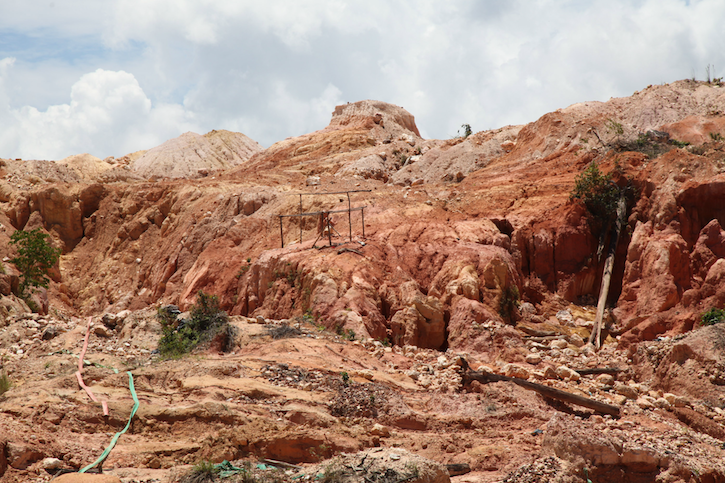
{1} André Bazin, “An Aesthetic of Reality: Neo-Realism,” in What Is Cinema?, trans. Hugh Gray, vol. {2} p. 38, Berkeley: University of California Press, 1971. Original publication Qu’est-ce que le cinéma? Volume 4, 1962.
{2} It was Paulo Tavares of the World of Matter research project, who brought this intriguing example of a democracy that is extended to the non-human to our attention. Also see Arturo Escobar, “Latin America at a Crossroads”, in Cultural Studies, vol. 24, No. 1 Jan. 2010, pp. 1-65, Routledge.
{3} Eleanor Ainge Roy, New Zealand river granted same legal rights as human being, The Guardian, 16 March 2017; and Ananya Bhattacharya, Pure waters, India’s sacred rivers now have human rights, Quartz India, March 21, 2017.
{4} The term Maroons, derived from the Spanish word for “escaped cattle”, is considered dehumanizing by some of the Surinamese forest communities. They prefer to call themselves “Businenge” (forest people); “Lowema” (people who walked); or “Fiima” (people who freed themselves).
{5} The black pages of our colonial history have only recently become the subject of an intense public debate. The annual protests against the practice of blackfacing during Sinterklaas, and the disputes surrounding the commemorations of statesmen and generals from the colonial era, cranked up the discussion. Does governor general J. B. can Heutsz deserve a statue for pacifying Atjeh in Indonesia? Or should he rather be defamed as a war criminal for killing thousands of civilians during his efforts to break the resistance against the Dutch colonial occupation? Can a school or tunnel be named after Jan P. Coen, while this Dutch governor general was responsible in the 17th century for killing thousands of inhabitants on the Banda Islands in Indonesia to restore the Dutch monopoly on nutmeg? Can admiral Michiel de Ruyter, whose strategic insights and bravery brought multiple victories to the Netherlands during the Anglo-Dutch wars in the 17th century, be celebrated with a mausoleum, statues, street names, and blockbuster films, while he also contributed significantly to the slave trade?
{6} The descendants of these people speak their own creole tongue: a mixture of words appropriated from the different European languages that were spoken by the slave masters: Portuguese-Jews, the English, and the Dutch.
{7} This particular phrase we borrowed from Richard Price’s, Travels with Tooy: history, memory and the African American imagination (2007), but the wisdom was passed on to us by the Aucan Stefano Damba, from Moengo.
{8} The grant called De Verbeelding rewards two projects every two years. The funding is contributed by the Mondriaan Fund for the Arts and the Netherlands Film Fund. Each of these state funds contributes 50% of the grant money. Nonetheless, Film Fund regulation prevails.
{9} This commission does not depend upon the film’s success.
{10} Literal translation from Dutch quitclaim.
{11} To achieve this, we had to renegotiate with the funders and switch producer. The new producer-trio, VRIZA, Ideal Film, and seriousFilm, were more attentive to the specific conditions of this project. All in all, the shuttling back and forth between opposing systems caused a year’s delay.
{12} Initially we wanted to shoot the film on analogue film stock but another prerequisite of the grant was that the film production needed to be insured. Insurance protocols prescribe that analogue film footage has to be delivered to a film lab within 48 hours after the shoot. These requirements could not be met in the jungle.
{13} “Political formations in the cinema of Jean-Marie Straub,” Martin Walsh, Jump Cut 4, 1974, p. 12-18).
{14} The expression ‘the parliament of things’ is borrowed from Latour’s essay “We’ve never been Modern,” 1993, chapter 5.5, p. 142. ‘Things’ refers here both to human and to non-human entities.
{15} Bakra refers to a white person but is also used to indicate westerners, and other outsiders and intruders.
{16} The nongo is extracted from the memory of Mr. Amoni from Grantatai, Bendikwai, to a dream recounted to him by Papa Awinga from Old Lombe in 1951. Also see Landveld, 2009.
{17} Maroons in Suriname address indigenous peoples as Ingi, or Indians. The Surinamese Ingi are mainly from the Arawak, Carib, Akurio, Trió, Warrau, and Wayana tribes.
CREDITS
Title Video: Citizens of Nature, Lonnie van Brummelen & Siebren de Haan (work in progress)
The script is based on conversations with:
basia Bernhard Bodji, Pantooli Doekoe, Elizee Jemisie, basia Esinoh Amania, Joney Doekoe, basia Alingo Doekoe (Edje), Oni Doekoe, Alfons Doekoe, captain Bappa Humphrey, Rudy Komada, Kaje Akobe, captain Nicolaas (Stiefen) Petrusi, Erwin Fonkel, Eddy Poeketti, basia Wee Wee Toboo, basia Nettie Kobita (Maa Tooy), Dinda Linga, captain Wee Wee Sofesie, captain Naldo Finki, Theo Maai, basia Joseph Adrie Prijor, Alfred Dirk Prijor, Eersteling brothers, Alida Adjoeba, Amoida Soeje, Sajee Baabo, basia Djansi Dodo, Abioni Dodo, Grieselda Waandels Snel, Nora Pamarie, Elmond Finisi, Thomas Finki, Petrus Adjako, captain Pomba Adjako, Sylvi Adjako, Oom Pei, basia Luben.
The conversations were moderated and mediated by Dorus Vrede, Hugo Jabini, Tolin Erwin Alexander. Additional moderators Paitoja Saaki and Duncan Prijor.
Translations of the conversations from Saamaka and Aucan into Dutch:
Vinije Haabo, Annelies den Boer-Aside, Suedy Mauricio, Erik Brunswijk, Kensly Vrede, Amayota Weewee, Kashmindra Vrede, Roxan Rahaman, Andoime Seedo. Translation of the script into English: Thijs Vissia. Books that also inspired the script: Vrede, Dorus, 1986, Rond het sterfbed van mijn dorp (Around the death- bed of my village), Paramaribo, Suriname, PAS.
Hoop, Carlo, 1991, Verdronken land, verdwenen dorpen (Drowned land, vanished villages), The Netherlands, Alkmaar, Stichting Bewustzijn. Price, Richard, 1983-2002, First Time: The historical vision of an African American people, the University of Chicago Press.
Price, Richard, 2011, Rainforest Warriors: Human Rights on Trial, the University of Pennsylvania Press.
Landveld, Erney, 2009, Alles is voor eeuwig weg: de transmigratie van de marrons in historisch perspectief (Everything is gone forever, the transmigration of the maroons in a historical perspective), Suriname, Paramaribo, Bureau Cosmos.
MacKay, Fergus, 2010, De Saramaka en hun strijd om het bos (The Saamaka and their struggle for the forest), The Netherlands, Amsterdam, KIT Publishers.
The script was composed by Lonnie van Brummelen & Siebren de Haan, adopted for the screen in collaboration with Darek Szai Szendel. Translation of the script into English: Thijs Vissia. Produced by Ideal Film, VRIZA, seriousFilm, Van Brummelen & De Haan. Line production in Suriname by Ann Hermelijn, ACO Multi service, Paramaribo.
Financially made possible due to the generous support of De Verbeelding (Mondriaan Fund and the Netherlands Film Fund); AFK; Fonds 21.
ACKNOWLEDGEMENTS
To cope with the two antagonistic systems that are active in this film we compiled a team of collaborators who know these structures from the inside. Theatre maker Tolin Alexander, lawyer Hugo Jabini, Saamaka linguist Vinije Haabo, and poet Dorus Vrede – Surinamese maroons from the Aucan and Saamaka tribes – mediated between the local communities and us, white outsiders. In dialogue with the director of commercials and film producer Darek Szai Szendel we unraveled the power structures of the film industry and developed the different audiovisual approaches for the multi-perspective narrative.
We thank Berry Vrede, Corine Spoor, Marcel Pinas, Erney Landveld for their support and advice during the research, and Patricia Pisters and Derek Szendel for their feedback to the introduction.
